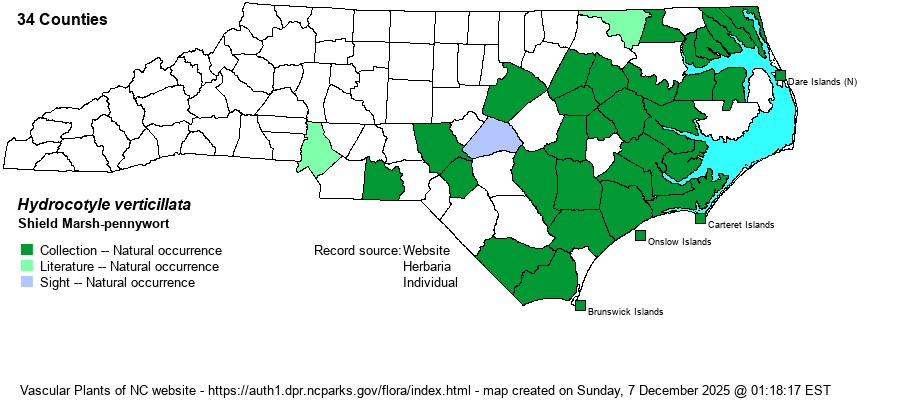| Author | Thunberg | |
| Distribution | Present over essentially all of the Coastal Plain, and barely ranges into the eastern and southern Piedmont. Both this species and H. tribotrys, which was formerly considered as a variety of this species, are present over nearly all of the Coastal Plain, and thus biologists need to take care in separating them. The website editors have been careful reviewing the SERNEC specimen data and feel that the two range maps are fairly correct and complete.
This is a Southern species, ranging north to NJ and MO, and southward to the Gulf Coast, and often found far inland from SC to AR (but not in NC). | |
| Abundance | Fairly common to common in most of the Coastal Plain, but rare to uncommon in the Sandhills region and in the northwestern portion. Very rare along the eastern edge of the Piedmont. | |
| Habitat | This species grows more often in shaded (mostly blackwater) wetlands than most others in the genus, found in swamps, shaded pools and margins, and along margins of blackwater rivers and creeks. The very similar H. prolifera overlaps in habitats but is more often found in sunny wetlands such as marshes and ditches. | |
| Phenology | Blooms from May to July, and fruits shortly after flowering. | |
| Identification | This is a semi-aquatic species, with fleshy leaf blades, but is rather small/short as compared with other species. It has a petiole about 6 inches tall, with a leaf blade that is orbicular and peltate (petiole attached to the middle of the leaf underside), but only about 2 inches across, with scalloped margins. The single separate flowering stem grows only about 4-5 inches tall, with several whorls of tiny white flowers along the axis. In this species, the flowers and fruits are sessile or subsessile, while in the closely related H. tribotrys these parts are on pedicels, anywhere from 1-10 mm long. This latter species also has a longer flowering stalk, typically taller than the leaves and thus the flowers are more obvious than in H. verticillata. Both of these are separated from others by a combination of peltate leaves and flowers all along a single, unbranched stalk -- in whorls and not in an umbel at the top of the stem. | |
| Taxonomic Comments | See above. References that do not separate H. tribotrys as a separate species thus name this species as H. verticillata var. verticillata. In either case, these two grow in dense stands like the others, but you will need to see the flowering stalks for identification.
| |
| Other Common Name(s) | Whorled Marsh-pennywort (used uncomfortably and incorrectly for both this species and H. prolifera), Whorled Pennywort, Shield Pennywort. As both of these species cannot have the identical common name, and a nested name -- like Whorled Pennywort -- is not the best idea -- the website editors are using one common name of Shield Pennywort to coin a newly used name -- Shield Marsh-Pennywort. | |
| State Rank | S4 | |
| Global Rank | G5 | |
| State Status | | |
| US Status | | |
| USACE-agcp | OBL link |
| USACE-emp | OBL link |

